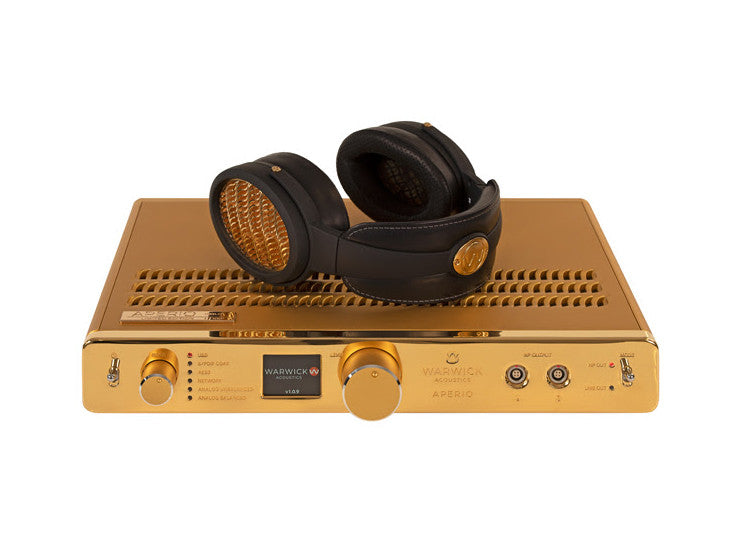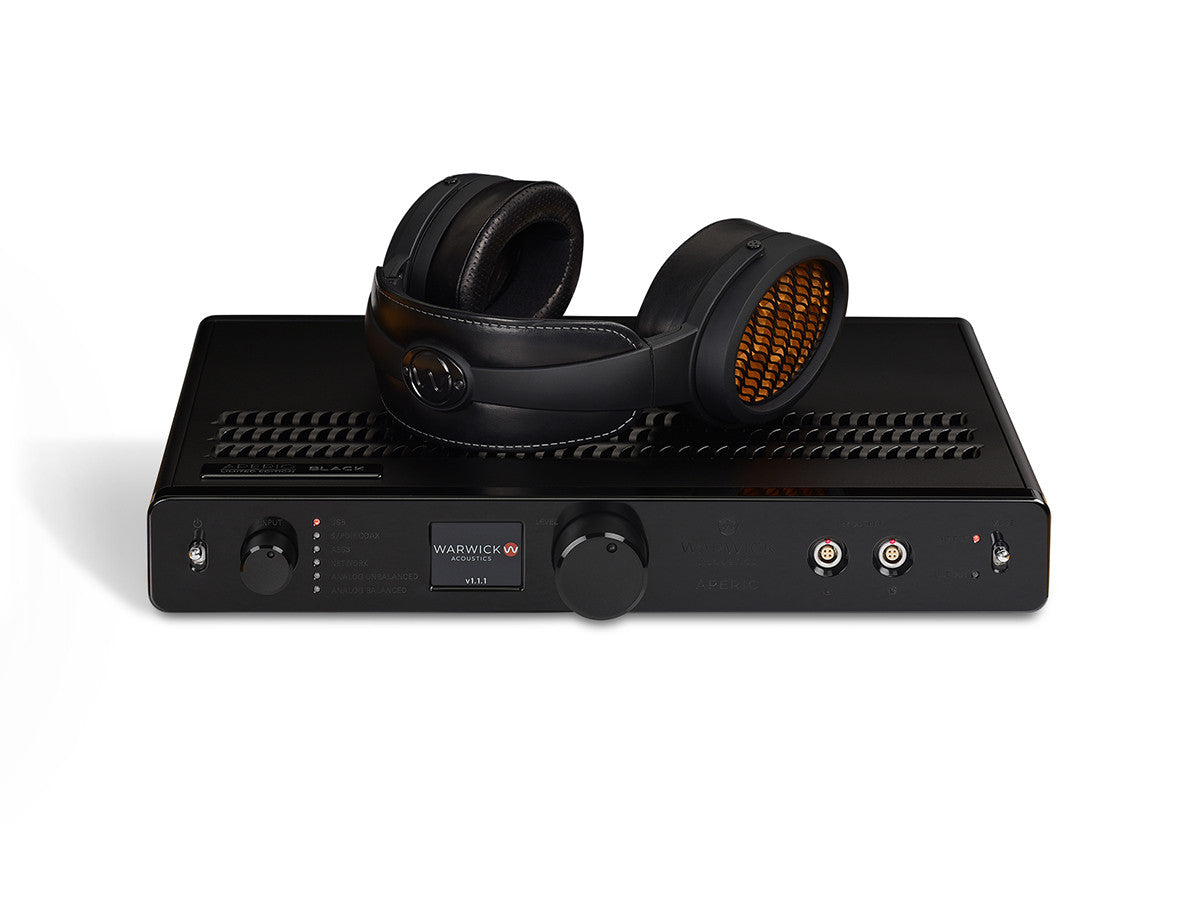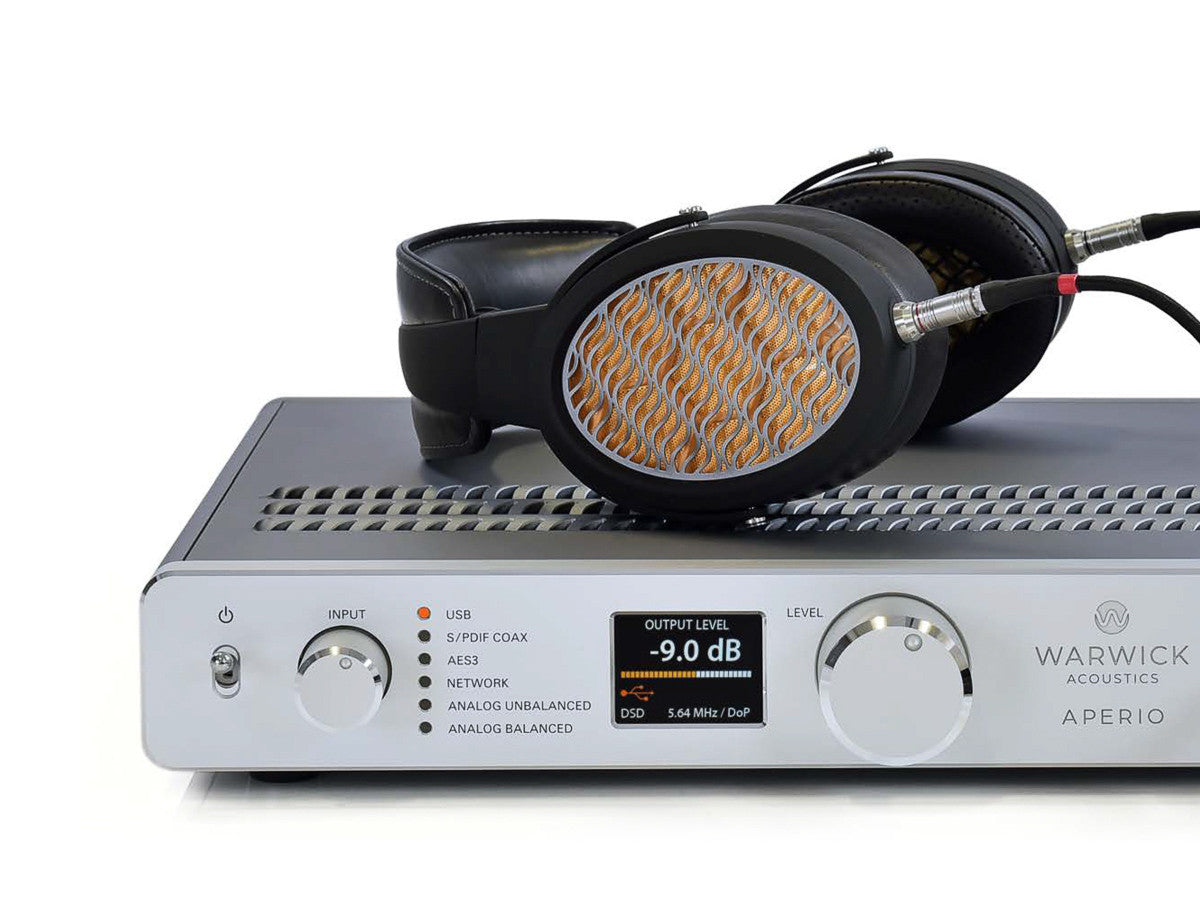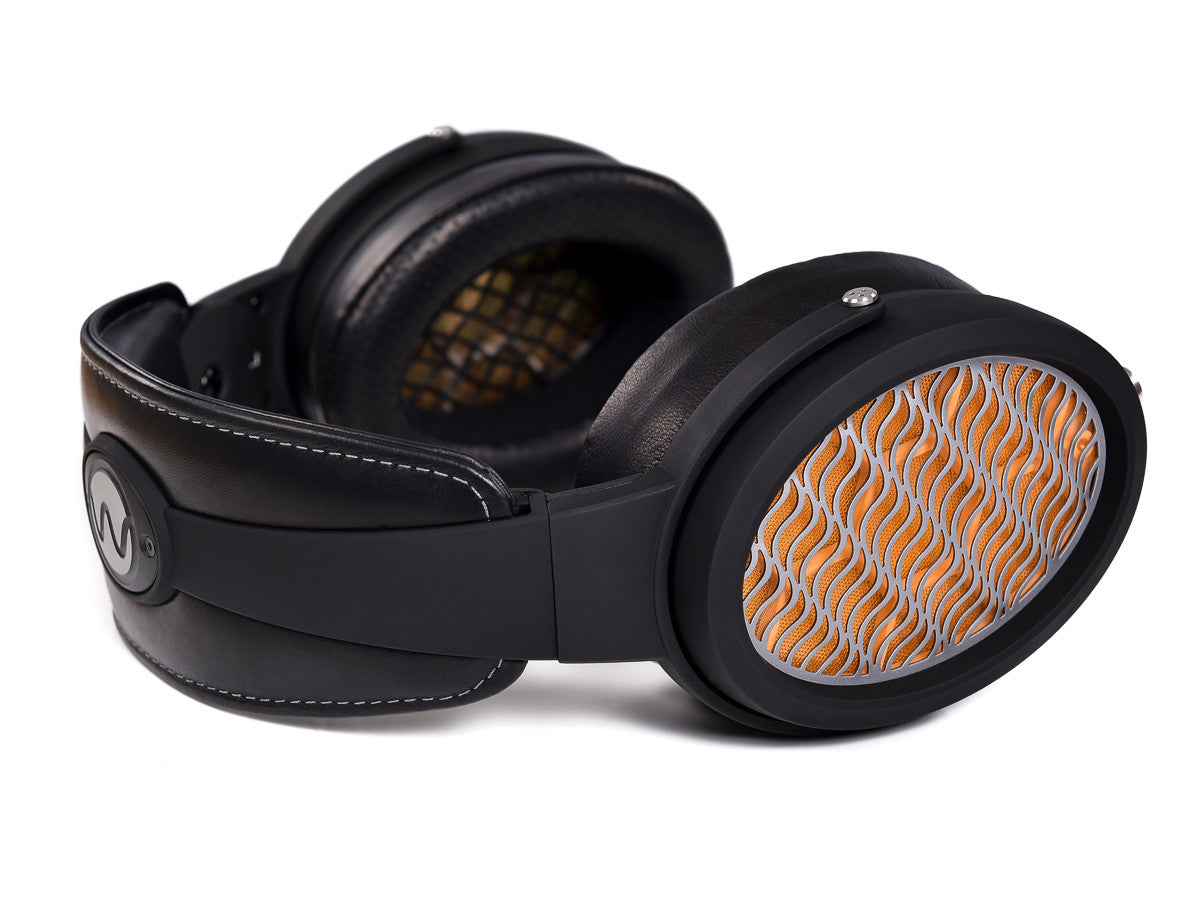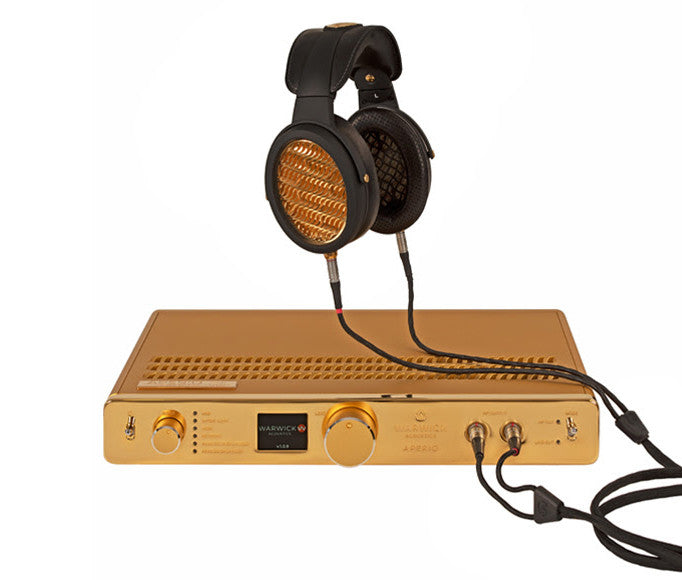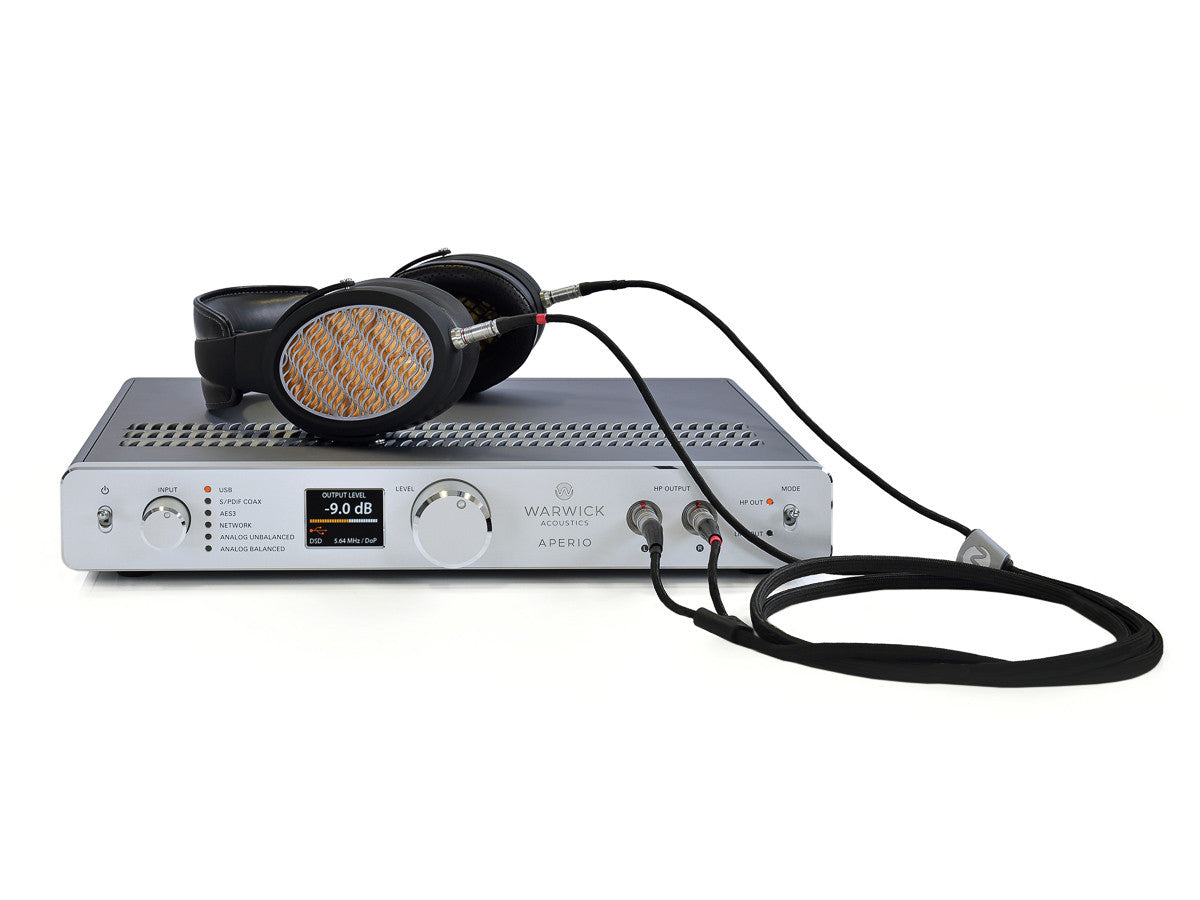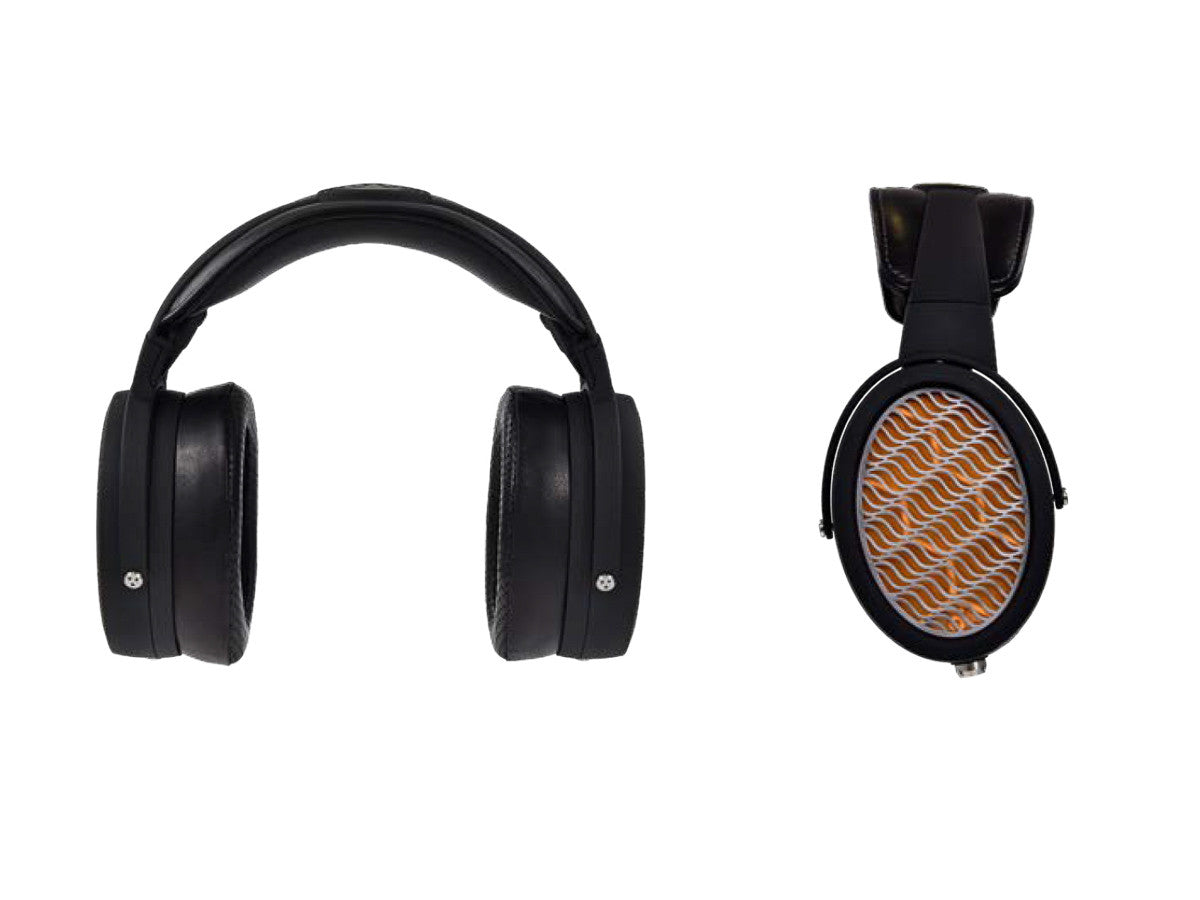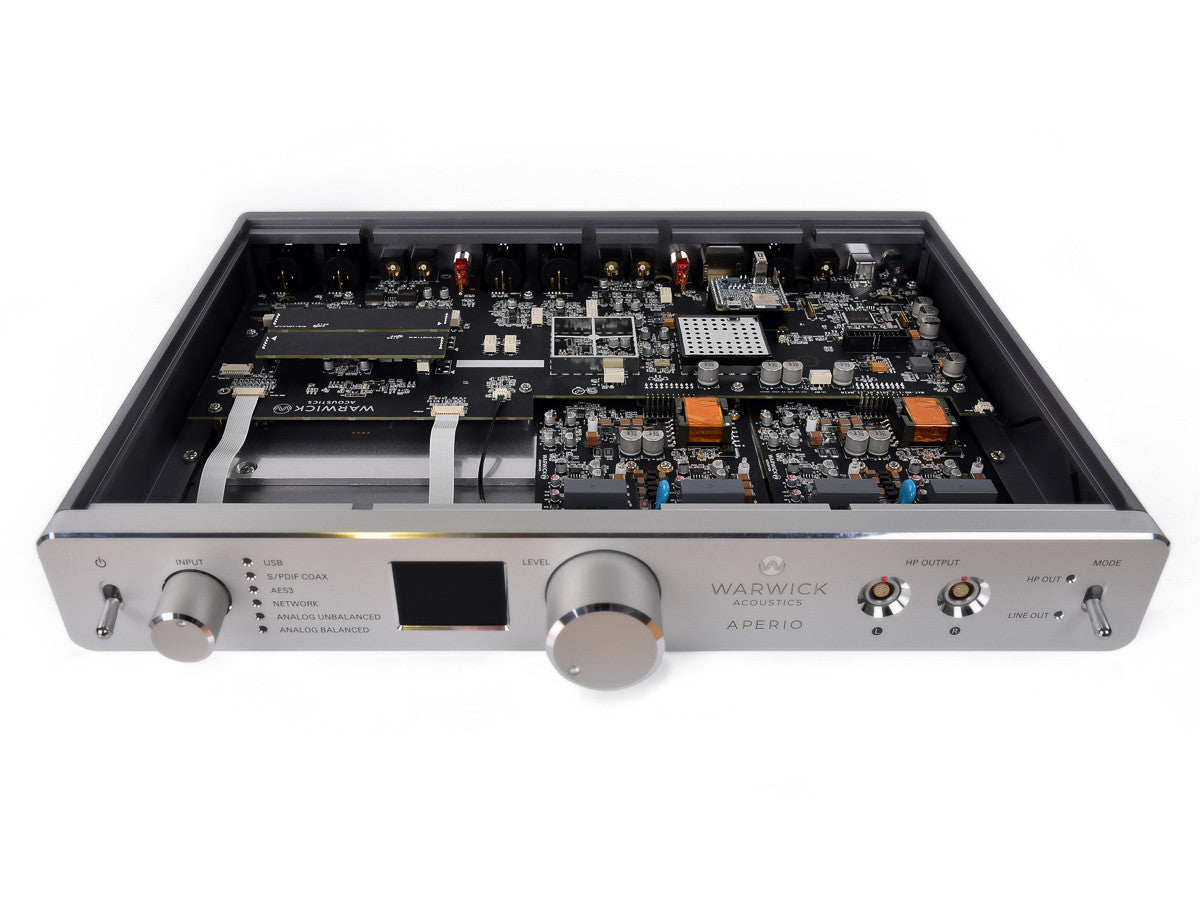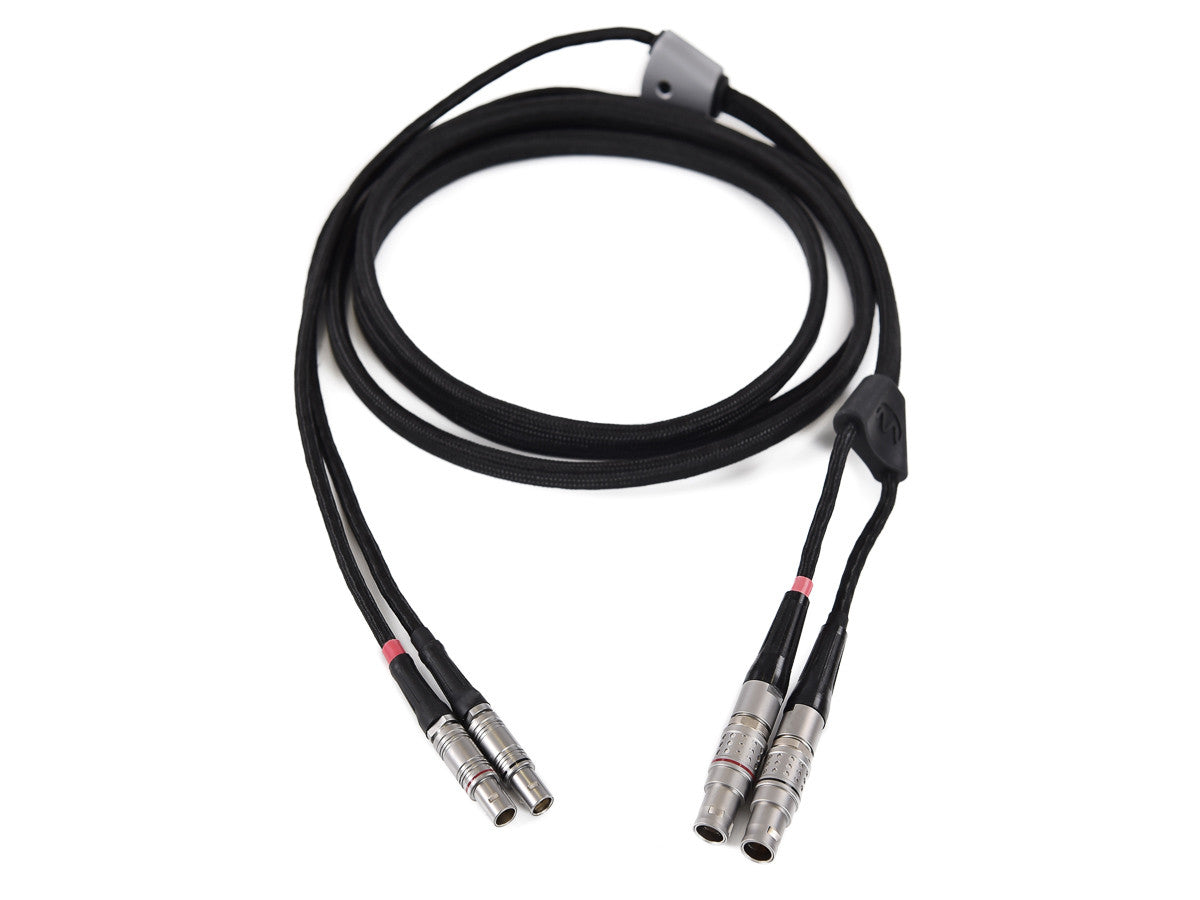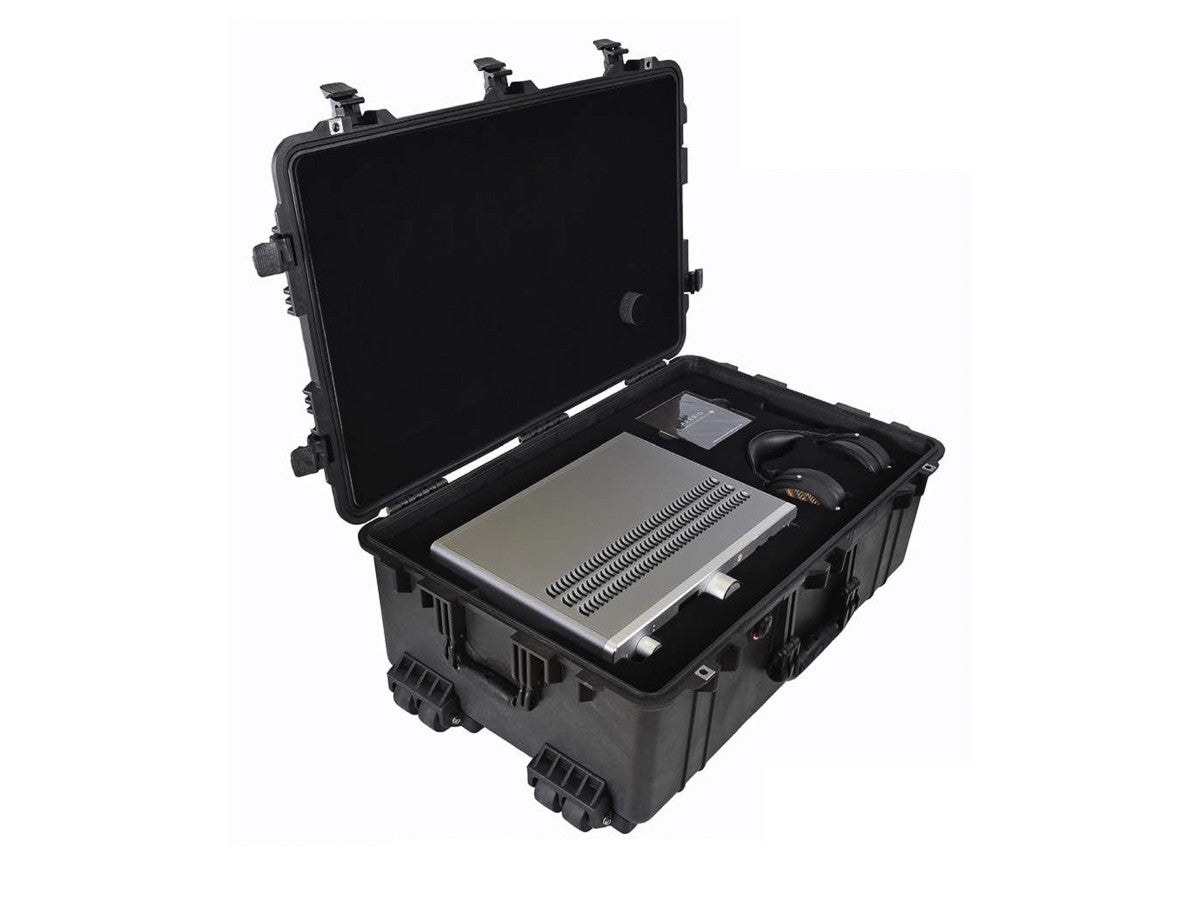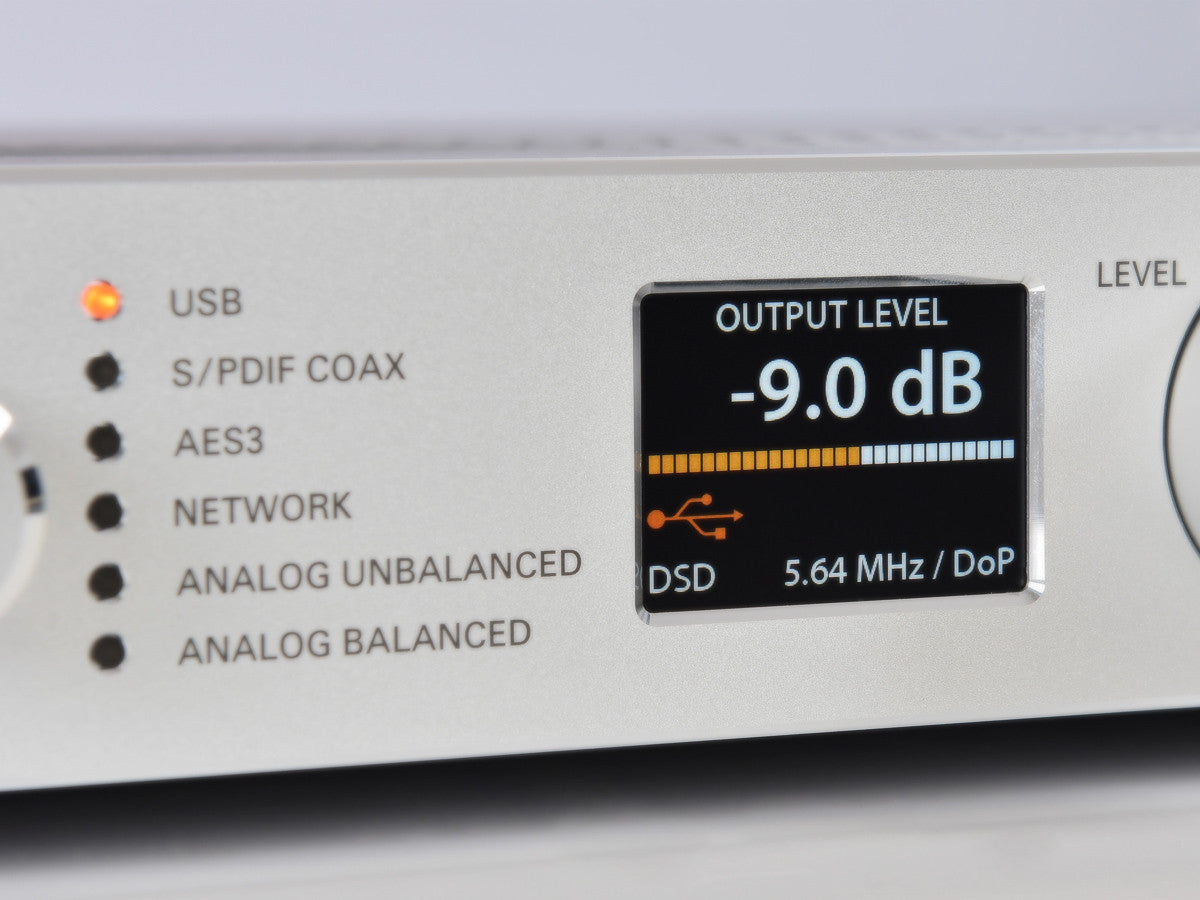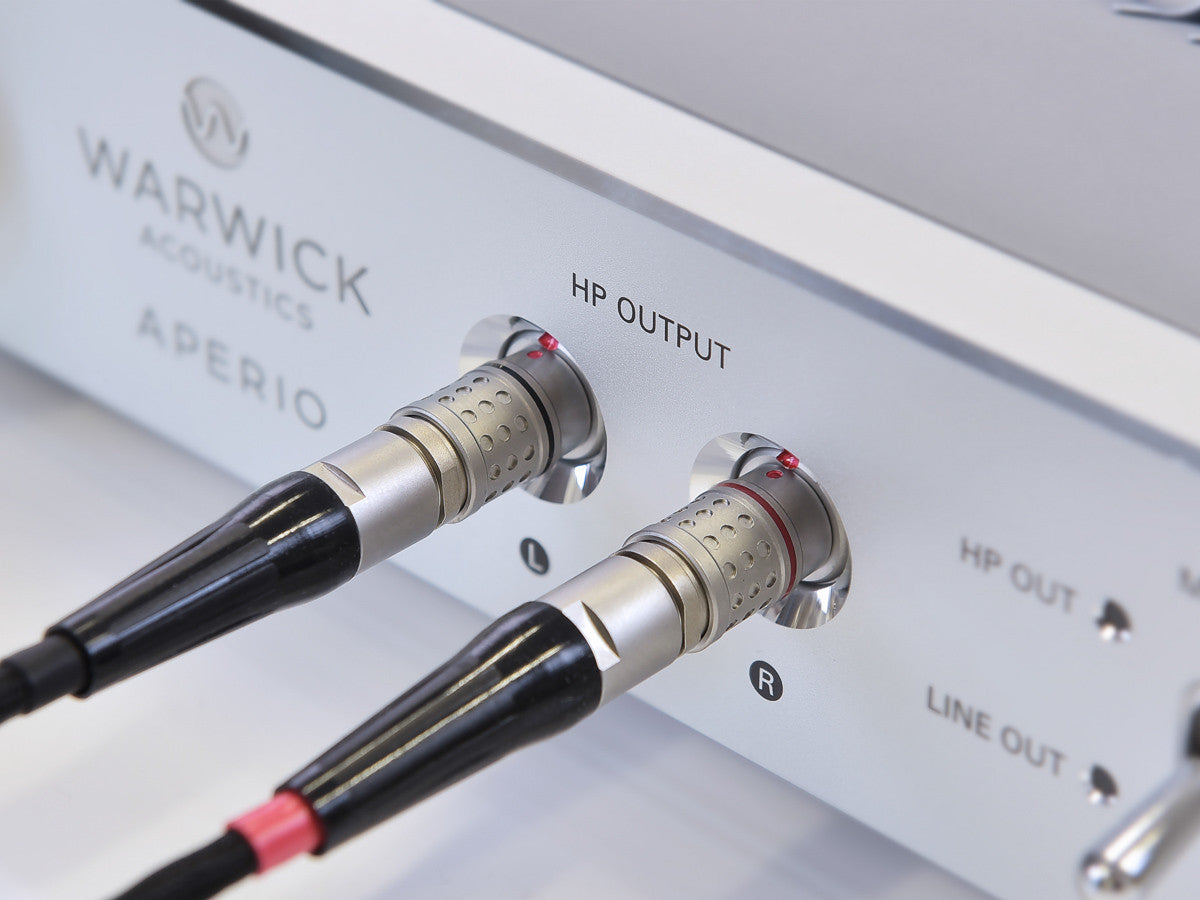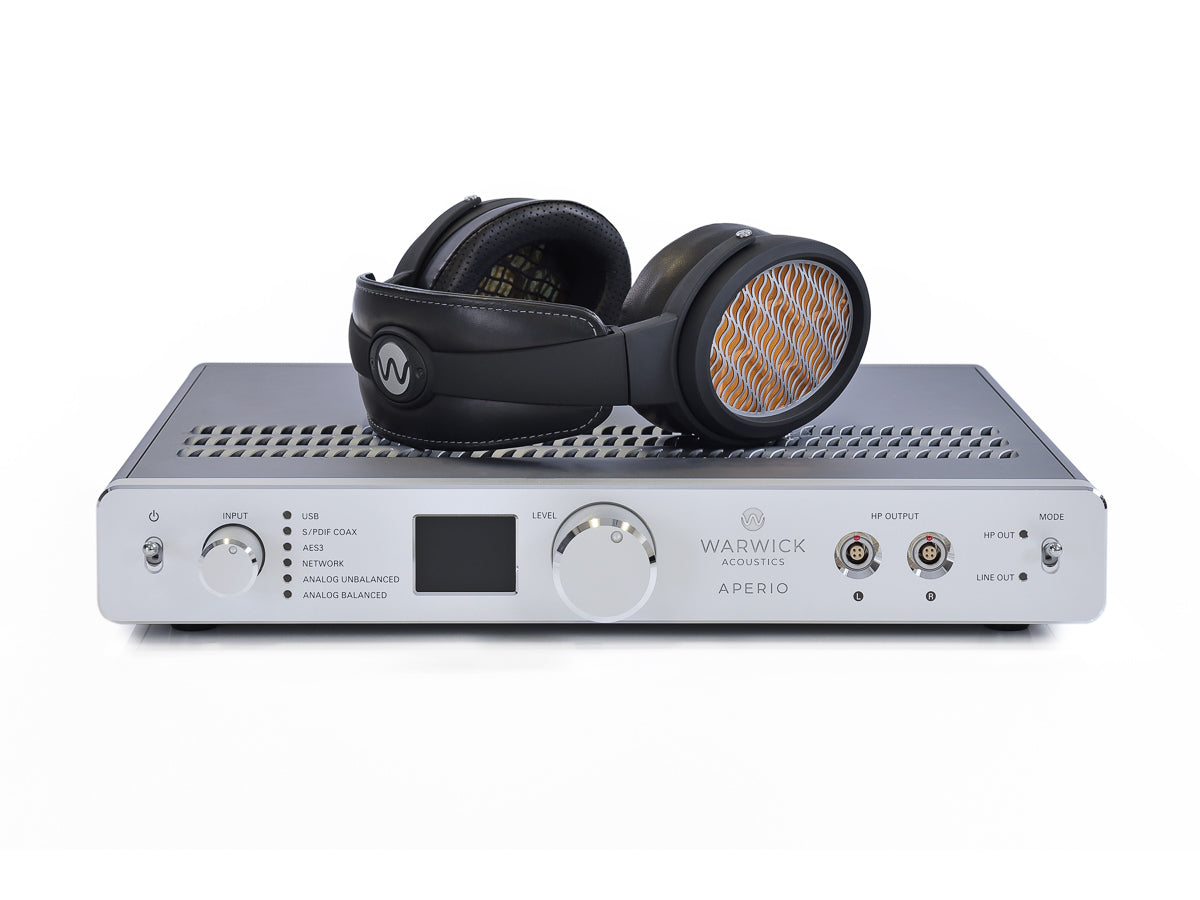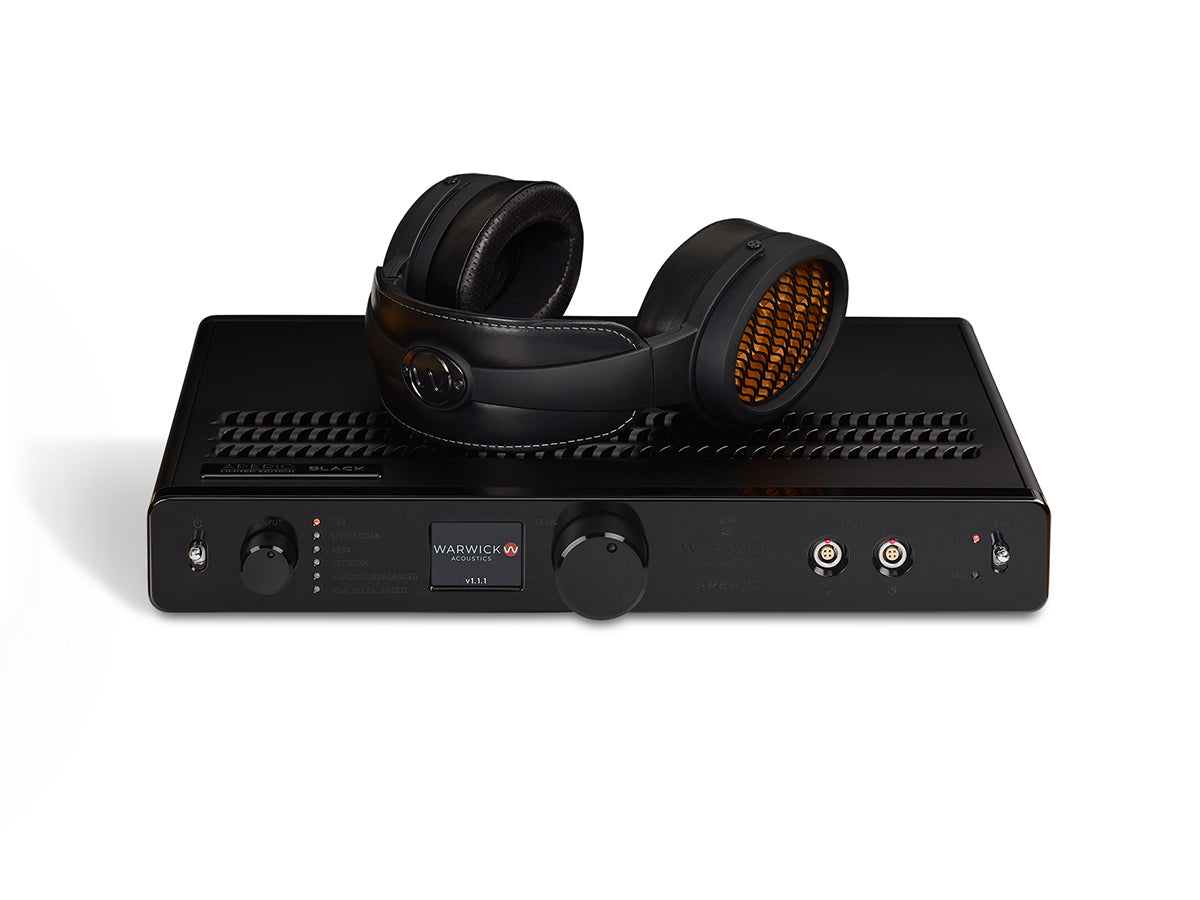






Warwick Acoustics
Aperio Headphone System
$35,000.00 USD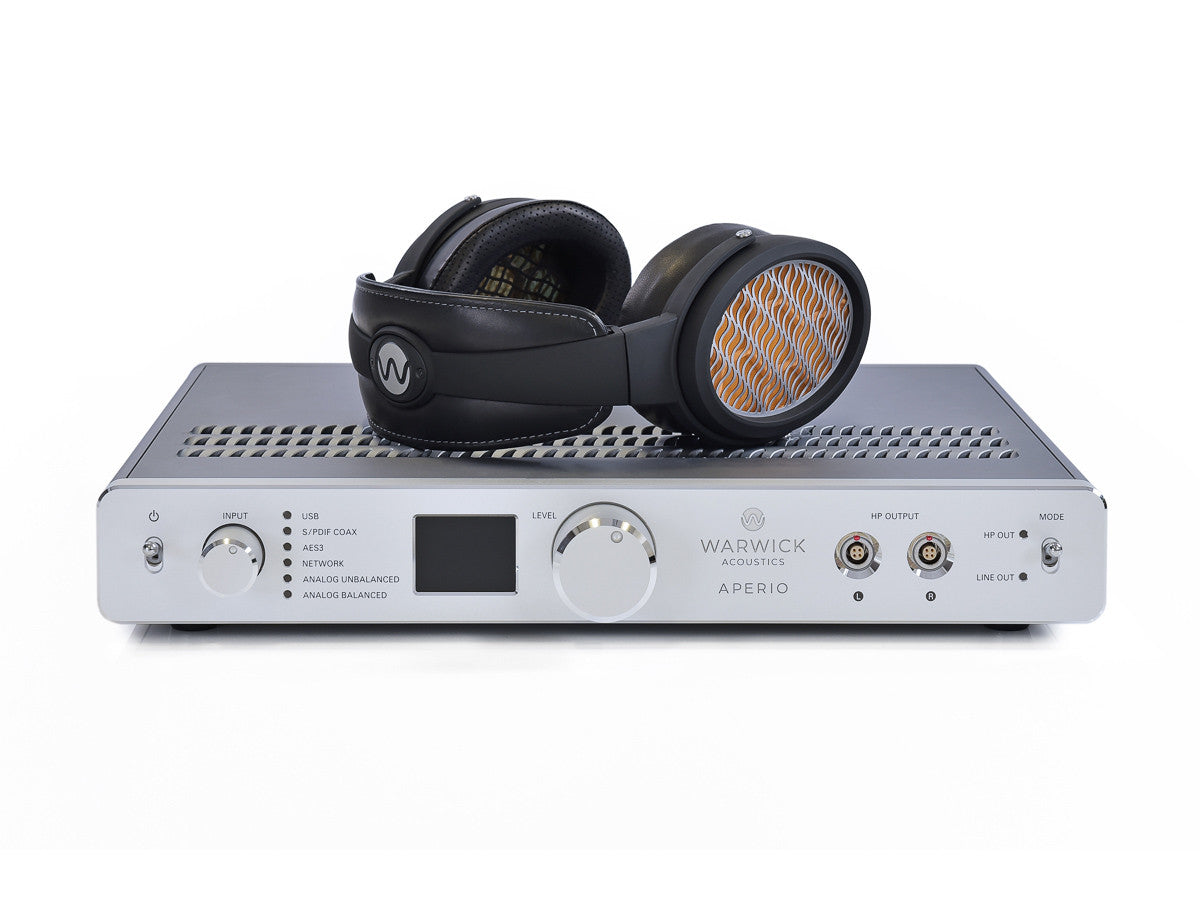
Features
The APERIO has been optimized for resolving the most minute, low-level details present on any form of audio media. These capabilities must be achieved without inducing distortion artifacts and other anomalies, such as “listener fatigue”. Sound reproduction quality and audio performance should be identical at all listening levels.
The APERIO features a wide range of inputs, including balanced and unbalanced analog, AES3 (AES/EBU), S/PDIF Coaxial, USB and Ethernet (LAN).
The APERIO is unique in being a fully networkable product that exceeds typical DLNA limitations and allows digital audio reproduction of native or DoP 256 fs DSD and higher sample rate PCM formats to 384 kHz.
Within the APERIO all audio signals are kept in their native domain and format: analog always remains analog; DSD stays DSD until its final conversion to analog; PCM sample rates are never converted. The signal path is pure, as direct as possible and unadulterated.
What's in the Box?
Warranty
The Warwick Acoustics APERIO is designed without compromise to set new standards in sound reproduction, and to redefine the level of audio performance achievable in a headphone system.
To Uncover, Open, Reveal
The model name for Warwick Acoustics’ flagship, reference headphone system is a literal match for our design goal: to reproduce and reveal all recorded audio content definitively, without alteration.
The APERIO is designed for the demanding professional audio market, as a reference studio monitor headphone system for High-Resolution Audio production, mastering, mixing and recording applications. Moreover, the APERIO is designed to be equally capable in ultra-high-end home consumer applications.
The APERIO reference headphone system strives to deliver the highest level of audio performance achievable, by means of our proprietary planar electrostatic technology.
The APERIO utilizes a highly-refined, evolutionary advancement of technology originally developed by Warwick Acoustics for it’s ground-breaking and multi-award-winning Sonoma Model One Headphone System.
Applications and Features

The APERIO is designed for demanding applications that require ultra-high resolution and higher output levels.
The APERIO has been optimized for resolving the most minute, low-level details present on any form of audio media. These capabilities must be achieved without inducing distortion artifacts and other anomalies, such as “listener fatigue”. Sound reproduction quality and audio performance should be identical at all listening levels.
The APERIO features a wide range of inputs, including balanced and unbalanced analog, AES3 (AES/EBU), S/PDIF Coaxial, USB and Ethernet (LAN).
The APERIO is unique in being a fully networkable product that exceeds typical DLNA limitations and allows digital audio reproduction of native or DoP 256 fs DSD and higher sample rate PCM formats to 384 kHz.
Within the APERIO all audio signals are kept in their native domain and format: analog always remains analog; DSD stays DSD until its final conversion to analog; PCM sample rates are never converted. The signal path is pure, as direct as possible and unadulterated.

The APERIO also features an exceptional Line Output section for driving other electronics and sound reproduction components that include outboard amplifiers and loudspeakers. Balanced and unbalanced outputs are capable of driving very long cables to the highest levels with prodigious current delivery. For studio applications, downstream components connected by 150-meter balanced cables can be driven to 15 dBu without distortion.
The Line Output feature, in conjunction with an uncompromised Digital-to-Analog Converter (DAC), preamplifier functionality and outstanding audio fidelity, enable the APERIO to perform optimally as the central hub of a state-of-the-art, two-channel studio monitoring system or ultra-high-end home audio system.
The APERIO indicates its output level in precise 0.1 dB increments via a front panel full-color, high-resolution display. This display also alerts the user if any faults such as output clipping, overheating or disconnected cables are detected.
The APERIO’s firmware is updateable via its USB input, using a simple APP for any Windows / MAC / Linux-based host. This feature allows users to keep the APERIO current and up-to-date over its full lifetime.
BD-HPEL Transducer
The single most crucial component of any headphone system is the transducer. The ultimate performance of the complete sound reproduction system will be determined and limited by the acoustical performance and fidelity of the transducer.
The APERIO utilizes a new Balanced-Drive HPEL Transducer (BD-HPEL) – a symmetrically-driven variant of Warwick Acoustics’ High Precision Electrostatic Laminate (HPEL) transducer, originally developed for the Sonoma Model One headphone system. The BD-HPEL was developed specifically for applications that demand the highest level of audio resolution and greater output capability.
The BD-HPEL requires symmetrical, high voltage drive signals to generate a differential, electrostatic force that moves the diaphragm. The BD-HPEL has twice the excursion capability, greater linearity and lower distortion than Warwick Acoustics’ first generation HPEL.
This next-generation HPEL transducer is built in the United Kingdom, at Warwick Acoustics’ state-of-the-art R&D facility. The BD-HPEL is manufactured under strict laboratory conditions using proprietary, semi-automated, cell-based production techniques. We control all aspects of sourcing, production, testing and quality assurance. Every transducer produced is tested in our lab, graded and matched within 0.5 dB to a complementary unit to form a matched-pair. Only the best-performing matched-pairs of BD-HPELs are installed in APERIO headphones.
The core technology of our BD-HPEL has been refined over several years to be impervious to environmental changes such as temperature and humidity variation, stable in performance and sound quality over time (even after years of daily use), and extremely durable. These characteristics have been achieved because of the simplicity and robustness of the design, utilization of only the finest materials available and Warwick’s proprietary manufacturing processes.
The BD-HPEL retains Warwick Acoustics’ patented cellular structure, which acts to significantly reduce and distribute resonant phenomena, and extends bandwidth to over 60 kHz. Subdivided cells act as smaller, phase-aligned planar sources, whose parallel-driven outputs combine acoustically to form a cohesive planar wave front.
Injected Magnesium Ear cups
Major structural components of the headphone, for example, the ear cups, are fabricated of injected Magnesium – a rigid material lighter and significantly better-damped than aluminium and most polymers. Because the Magnesium is injected, complex and precise components that typically would require CNC-machining are possible. Key structural fasteners are fabricated from stainless steel for strength and durability. Gaskets are formed from closed-cell foams that are well-damped and free from compression-set.
The mechanical design is robust and employs the finest materials available for each functional purpose. Even the two-stage finish was selected for its excellent damping properties and durability. The result is a mechanical foundation that is extremely rigid, well-damped and free from resonances.
The development team carefully designed the ear cup components to minimize acoustical reflections and diffraction, on both sides of the transducer. Similarly, acoustic impedance is optimal on each side of the transducer. The APERIO is extremely "open" to the surrounding air, with a minimum of obstruction between the transducer diaphragm and the listener’s ear. Unlike most headphones, the APERIO does not have regions over the transducer covered with acoustical materials that impede air flow or spectrally filter the sound (aka, passive equalization). This common approach is not needed for the APERIO and has deleterious effects on sound quality, especially with regard to detail, resolution and sonic neutrality.

Headphone Comfort
The APERIO addresses comfort by minimizing weight and optimizing geometry. The advanced materials utilized in the design, such as Magnesium and Engineering polymers, result in a very low mass of 405 grams.
The headband has been designed around the ideal geometry for a wide range of head sizes, with the optimum clamping force to ensure a good air seal and stability on the head, without excessive pressure that could be problematic during long listening sessions. The headband maintains this optimum clamping force over the full range of adjustability (extension of the headband and ear cup position).

Ear Cushions
In order to achieve outstanding low frequency performance, the APERIO requires a small sealed air volume between the transducer and listener’s head. The APERIO maintains this air volume and requisite air seal through key design features that eliminate air leakage, even with variations in head and ear shape.
And in order to minimize acoustical standing waves within the enclosed air volume, which in turn create resonances, the ear cushions feature acoustically-absorbent foam around their inside perimeter. The ear cushions maintain the necessary air seal to the user’s head while absorbing damaging acoustical reflections within the enclosed air volume.
The ear cushions are designed to improve cooling around the user’s ears via perforated top surfaces and a copper thread mesh that dissipates heat. The ear cushions are covered in the finest, natural, top grain Cabretta leather that is sustainably sourced.
Because high voltages are required for operation, the APERIO is designed with a high degree of electrical isolation and multiple safety features. The BD-HPEL transducer is electrically isolated from the conductive Magnesium components. The headphone body is electrically grounded and features double-insulated electrical connections; internal wiring is insulated with High Voltage Silicone and Teflon. High performance, polarized, self-latching, stainless steel connectors with gold-plated copper, multi-pole contacts are utilized for electrical connection to the headphone cable.
Cutting-Edge Components
Because the APERIO is a complete sound reproduction system, the electronics are optimized specifically for the APERIO headphone. Every element of the sound reproduction chain between raw audio data input (from an analogue or digital source) and output to the headphone is included and fully optimized within the APERIO electronics.
Every functional sub-section of the electronics has been designed to state-of-the-art standards, without compromise. And as a complete system, each section works together seamlessly and synergistically to achieve audio performance superior to individual components, especially within the context of driving the APERIO headphone.



The APERIO electronics comprise the following audio functions: full-feature preamplifier with line output, digital-to-analogue converter (DAC) and headphone amplifier, including bias voltage "energizer". The APERIO preamplifier function includes a wide range of inputs: balanced and unbalanced analogue, AES3 (AES/EBU), S/PDIF Coaxial, USB and Ethernet (LAN). The analogue inputs feature independently switchable gain and differential buffer circuitry to maximize audio performance for analogue signals ranging from low-level consumer audio (< 1.0 Vrms) to high-level professional audio (up to 18 dBu). Digital inputs feature state-of-the-art PLL input circuitry and asynchronous clocking for USB and Ethernet sources.
Within the APERIO electronics, all analogue circuitry and PCB routing is differential (balanced), with gain levels carefully optimised between all stages to maximize Signal-to-Noise Ratio (SNR). The topology is as simple as possible to minimise the number of stages and devices that the audio signal must pass through. All audio routing and switching is performed using the finest signal relays, with gold-plated silver contacts.
The audio signal is not routed through internal cables and never passes through panel switches or potentiometers. All circuitry in the APERIO electronics, including power supply regulation, employs a Dual Mono topology to minimize crosstalk and interference between channels.
Only the finest active and passive components are utilized in the APERIO circuitry. Cutting-edge ICs and high voltage discrete transistors are selected and applied in circuitry based upon best audio performance and sound quality achieved. The highest quality 0.5% tolerance metal film resistors and 2% tolerance polymer film capacitors are utilized in critical circuitry.
The APERIO electronics have been designed to minimize mechanical resonances and the transmission of vibrational energy that could modulate low level audio signals in sensitive circuitry. The aluminium chassis sections interlock and are fastened together using stainless steel hardware with thread-locking compounds (to prevent loosening and vibration over time). The complete assembly rests on specialized mounting feet, formed of a highly-damped thermoplastic compound (IsoDamp C-1002), that isolate the enclosure from external shock and vibration. Internal PCBs also are very well damped due to the glass-epoxy substrate and double-thickness copper.
Analogue Line Output
The Analogue Line Output section features a novel Class A circuit that can output very high voltages with prodigious current, allowing it to effortlessly drive outboard electronics in any professional or consumer application, even with extremely long cables.
We’ve tested the Line Output section with 150-meter-long balanced cables driven to 15 dBu (12.3 Vp-p) without distortion.
Dual 32-bit, 8-channel DACs
The DAC section of the APERIO electronics is truly state-of-the-art. Dual 32-bit, 8-channel DACs are utilized – one per channel in dual mono configuration, to achieve a SNR of 131 dB. Each channel’s DAC section is housed within separate EMI shields ("cans") and supplied by isolated, local, ultra-low-noise power regulators.
The APERIO features a very unique level control (volume adjustment) configuration to preserve audio quality.
Dual domain level controls are implemented – an analogue attenuator for analogue and DSD signals, and a digital attenuator for PCM digital signals. The analogue attenuator is based on parallel, laser-trimmed resistance ladder networks and is fully differential. The digital attenuator is DSP-based with optimal re-quantisation and dithering to eliminate "zipper noise" and other anomalies. Both attenuators are calibrated and matched.

Input Cables
Warwick Acoustics supplies two high performance input cables with the APERIO: a USB 2.0 Type A to B cable, and an Ethernet cable. These cables are custom designs, developed by Warwick Acoustics to match the performance and quality level of the rest of the APERIO system. Both cables utilise superior SF/FTP construction, with double overall shielding (aluminum-mylar foil and copper-plated Aramid fiber braiding) as well as internal shielding of each of the double-helix twisted pair conductors. All internal data wiring is formed from 66 strands of micro-fine OFHC copper per conductor, each plated in pure Silver. The wiring insulation is high-grade Polyethylene (PE), with a very low dielectric constant (< 2.0). The outer jackets are formed from low durometer Thermoplastic Elastomer (TPE) covered with a multi-filament woven Polypropylene braid for durability and a soft texture.
The USB cable connectors are high-quality, gold-plated Type A and B plugs. The USB cable is designed to be impervious to noise, interference and emissions while maintaining an optimal 90 Ω characteristic impedance over the full operating bandwidth; it is fully compliant with USB 2.0 standards. The Ethernet cable connectors are the finest quality, ruggedised plugs available: professional, full-metal shielded XLR (RJ45) type from Neutrik and universal, full-metal shielded RJ45 type from Telegartner. The Ethernet cable also is designed to be impervious to noise, interference and emissions and maintains an optimal 100 Ω characteristic impedance over the full operating bandwidth. While the connectors are certified as CAT6A type, the cable is compliant with CAT7 standards.
The APERIO electronics are assembled in the Bay Area of California, USA, by skilled technicians using cell-based production techniques. All units are fully tested and measured to verify audio performance after assembly, with individual test results provided for every unit produced.
Travel Case
The complete APERIO system, (headphone, electronics, accessories), is packaged in an exceptionally durable travel case, formed of heavy-duty Polypropylene.
This case is watertight, crush-proof, and dust-proof, and features an automatic pressure equalization valve that balances interior pressure, keeping water out. The case also features a retractable extension handle, stainless steel hardware and four polyurethane wheels. This rugged case provides complete protection of the entire APERIO system and enables it to be conveniently transportable.
What's in the Box?
- APERIO headphones
- DAC/amp/energizer unit
- Power supply
- Headphone cable
- Ethernet cable
- USB cable
Headphone Specifications
- Configuration
- Open-back; circumaural type
- Transducer
- Balanced-Drive High Precision Electrostatic Laminate (BD-HPEL)
- Effective Diaphragm Area
- 140.5 in2 (3570 mm2)
- Frequency Response
- 10 Hz - 60kHz
- Output Level (SPL)
- Compliant with EN 60065/A12:2011 (EN50332) when driven by APERIO electronics (for all inputs)
Digitial Input: ~104 dB;br />Analog Input: ≥106 dB (continuous, est.)
- Ear and Headband Cushions
- "Cabretta" top-grain, sheepskin leather;
perforated surface on ear cushions - Input
- Polarized, 4-pin, self-latching connectors for left and right channels
- Drive Cable
- Dual Mono, shielded, ultra-low capacitance;
Silver-plated OFHC ultra-fine stranded copper with silicone insulationand Kevlar reinforcement;
2 meters - Weight
- 14 oz. (399 grams) without cable
Electronics Specifications
- Balanced Analog Inputs
- Dual (female) XLR jacks; switchable (high / low) input range; 18 dBu / 10 dBu
- Unbalanced Analog Inputs
- Dual RCA jacks; switchable (high / low) input range; 5.0 Vrms / 2.1 Vrms
- USB Digital Input
- Type B jack; USB 2.0; accepts digital audio formats up to 32-bit / 384 kHz PCM and DSD (DSD64/DSD128/DSD256) via DoP or Native
- Network (Ethernet LAN) Digital Input
- RJ45 jack; DLNA-compatible; accepts digital audio formats up to 32-bit / 384 kHz
PCM and DSD (DSD64/DSD128/DSD256) via DoP or Native - AES3 (AES/EBU) Digital Input
- XLR (female) jack; accepts digital audio formats up to 24-bit/192 kHz PCM
- S/PDIF Coaxial Digital Input
- RCA jack; accepts digital audio formats up to 24-bit/192 kHz PCM
- Line Outputs
- Balanced and unbalanced, high current outputs; +5 dB gain; switchable
- Digital Formats
- PCM: 16-32 bit / up to 384 kHz; DSD: up to 256 fs DoP and Native
- Equalization
- HP only: digital EQ (DSP) for PCM sources; analog EQ for analog and DSD sources
- Digital Signal Processing (DSP)
- 64-bit (double-precision) fixed-point processing at native sample rates
- Switchable Gain
- Rear panel switch; high level / low level selection for balanced analog input (professional audio and consumer levels) and unbalance analog input
- Source Selection
- Multi-position front panel selector with indicator LEDs for all sources
- Level Control
- Front panel, 31-position; digital and analog domain colume control (HP & Line Out)
- Status Display
- Front panel, 51mm, full color, QVGA, TFT LCD (240 x 320 pixels)
- Display Functions
- Digital readout and bar graph of volume control setting; display of digital audio data format; display of rear panel analog input (gain) settings; display of Ethernet and USB data link transmission lock; display of detected fault modes and output clipping
- Auto Fault Detection
- Automatic detection, display and protection for: output amplifier clipping, unplugged connections and malfunctioning wiring, over-temperature conditions and internal electrical faults
- DACs
- 2 x dual mono, 32-bit / 384 kHz DACs with balanced outputs, for PCM & DSD inputs
- Amplifier/Energizer
- Balanced, discrete MOSFET, high-bias, single-ended Class A output; dual mono topology, including power supple; 18 00 CDC bias (charge) voltage
- Distortion + Noise
- <0.001%
- Bandwidth
- >65 kHz
- Enclosure
- CNC-machined 6063 aluminum
- Power Supply
- External: world voltage compatible (90-264 Volt AC, 50-60 Hz); 24 Volt DC, 200 VA (8.333 A), fixed frequency, class B-compliant SMPS;
Internal: isolated, dual mono; switching and ultra-low-noise linear regulation - Types B, G, F, I; IEC-60320 C14, earth- grounded power cable; 1.5 meter length
- Dimensions
- H x W x D: 68 mm (2.68 in.) x 413 mm (16.26 in.) x 351 mm (13.82 in.)
- Weight
- 7.4 kg (16.28 lbs.), without Power Supply
NOTE: All specifications shown are subject to change without notice.

